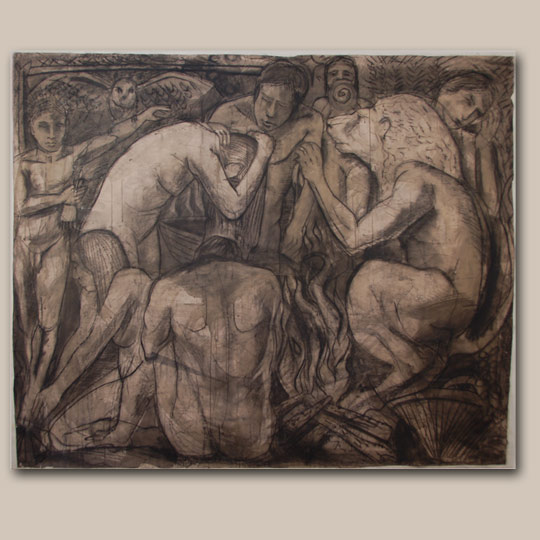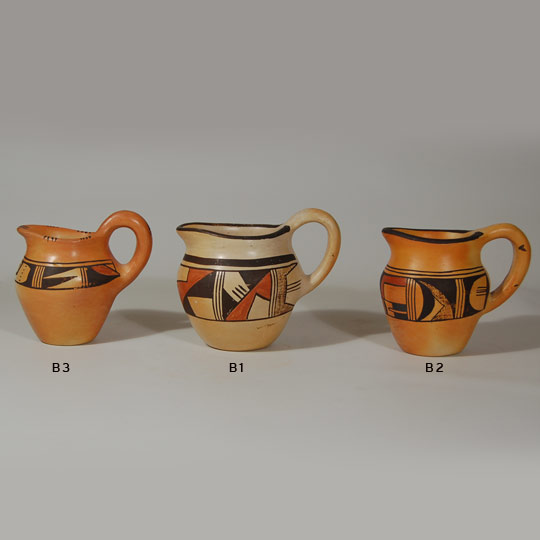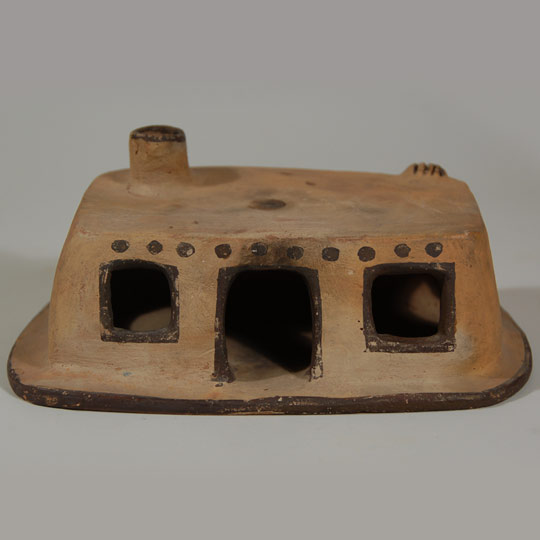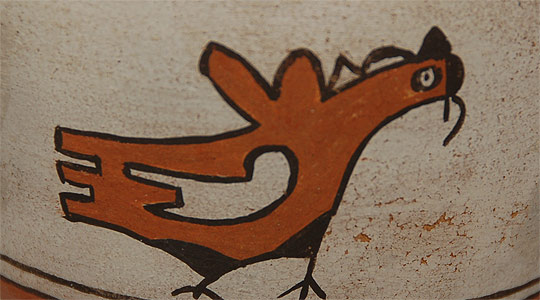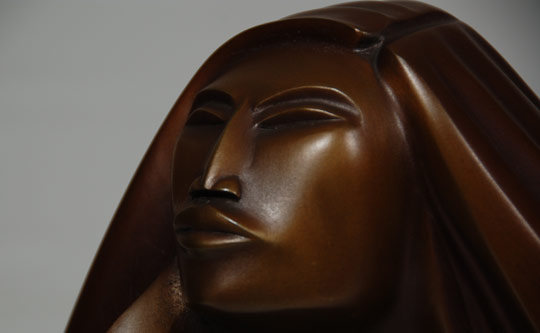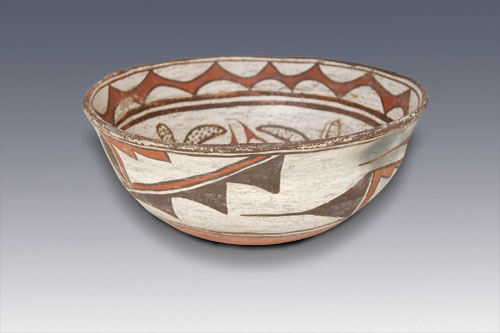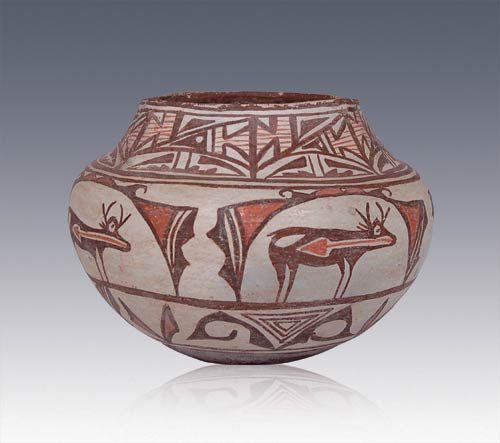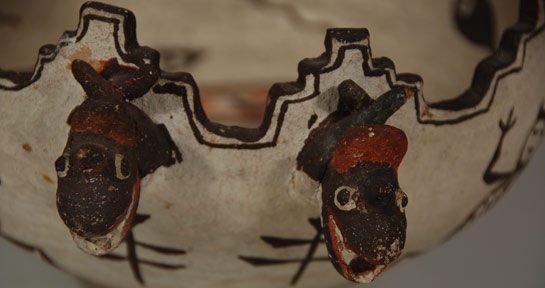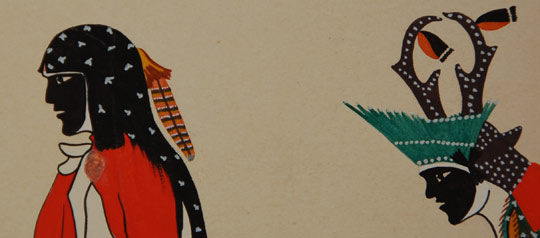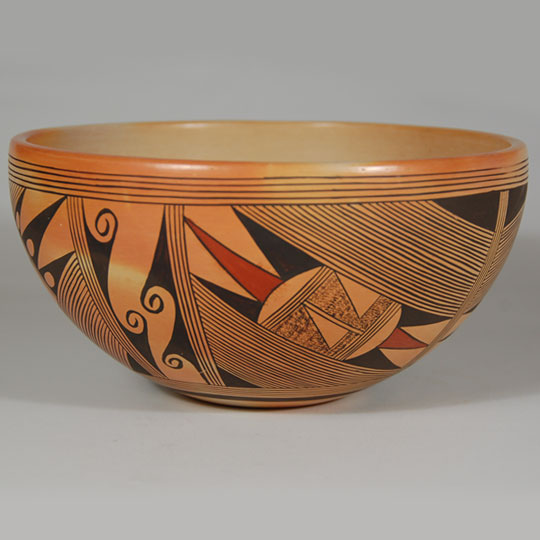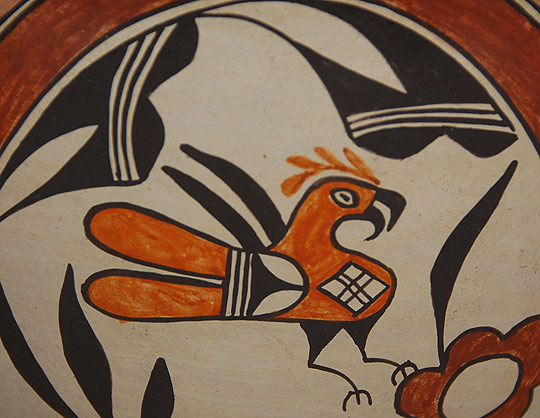Title: Original Painting Entitled "The Healing"
This charcoal and ink wash was executed on paper which was then mounted on canvas. It is one of four such paintings by Tony Abeyta based on dreams he had in the late 1980s. Unfortunately, three of the paintings were destroyed in a fire and this is the only survivor. It was executed in 1987-1989.
The scene depicts a healing ceremony. The female in center is having her hair ceremonially washed. The fire to her right is a purification symbol. The young boy in the far left carries a medicine bag in one hand and has an Owl, a very powerful symbol to the Diné, on his outstretched arm. He seems to be wearing a crown. He is either standing behind or in another fire. The Lion in the far right is a healing figure-almost Sphinx-like. The young girl above the head of the lion is blowing a shell trumpet. There is a small boat in the background about center of the painting. In the front, right corner, is a chamissa plant. The male and female in the foreground represent participants in the ceremony. The overall painting is very mysterious and was based on a dream Abeyta had at the time. He recently stated that he has a hard time now describing what he felt at the time that he painted this scene.
The painting was executed on paper in charcoal and ink wash. It was then mounted on canvas and stretched to a wood frame. It has not been framed. Before it was attached to the canvas, a few small sections of paper received minor damage and it has been decided, in consultation with the artist, that it is best left as it is because the tears are basically not visible and the paper if fixed to canvas so no further tears can occur. It has been signed by the artist on the front and back. He also titled and dated the painting on the back.
Provenance: from a family collection in Taos, New Mexico
Recommended Reading: 100 Artists of the Southwest by Douglas Bullis (This hardback book is an excellent resource for reading about and seeing art by 100 Southwest artists-both Indian and non-Indian. Tony Abeyta is included.
Title: Original Painting Entitled "The Healing"
Artist: Tony Abeyta (1965-present)
Category: Paintings
Origin: Diné - Navajo Nation
Medium: charcoal and ink wash on paper/canvas
Size: 62" x 75" image
Item # C3350
Subject: Hopi Pottery Cream Pitchers
Paqua Naha, whose first name translates to "frog," is known as Frog Woman. She was the first to carry this name. After she passed away, her daughter, Joy Navasie, became Frog Woman. Paqua worked mostly in "black and red on yellow," referring to black and red designs on yellow un-slipped pottery. It was she who developed the white pottery that is now the Frog Woman hallmark. She passed away about three years after developing this style and Joy continued producing it until she passed away last year.
These are three pottery creamers, all made and signed by Paqua. We are posting them together but they are available for purchase individually.
The one labeled B1 measures 3-3/4" tall x 3-3/4" diameter. It is in excellent condition with some abrasion to the painted design, but nothing of significance.
The one labeled B2 measures 3-7/8" tall x 3-1/8" diameter. It too is in excellent condition with only very minor abrasion to the brown paint.
The one labeled B3 measures 3-1/2" tall x 3" diameter. It also is in excellent condition with only very minor abrasion to the brown painted design.
All three are signed on the underside with the Paqua frog hallmark.
Provenance: from the collection of a gentleman in Colorado
Recommended Reading: Ray Manley's Collecting Southwestern Indian Arts & Crafts. This 1979 paperback book does not feature pottery by Paqua, probably because she was no longer living when it was published, but there is a good spread on her daughter, Joy Navasie.
Subject: Hopi Pottery Cream Pitchers
Artist / Potter: Paqua Naha (1890-1955) Frog Woman
Category: Contemporary
Origin: Hopi Pueblo
Medium: clay, pigment
Size: 4" tall x 3-1/2" diameter approximately
Item # C3354B
Subject: Jemez Pueblo Single Story Pottery House
Pottery house structures such as this seem to have been popular in the early- to mid-20th century. They were made by potters at several of the pueblos and were intended as inexpensive items to sell to tourists enchanted with New Mexico and its low adobe houses. They have become quite collectible now. It is difficult to place a date on most of them but probably mid-20th century or earlier is a good guess.
Condition: overall in excellent condition except that a small corner of the ground plane in the rear of the house broke off and has been glued back on and it truly is not noticeable.
Provenance: from a Santa Fe collector of pueblo pottery
Recommended Reading: Indian Arts and Crafts by Marjorie Miller
Subject: Jemez Pueblo Single Story Pottery House
Potter Unknown
Category: Contemporary
Origin: Jemez Pueblo
Medium: clay, pigment
Size: 4" tall x 3-1/2" diameter approximately
Item # C3190F
Subject: Santa Ana Pueblo Traditional Design Polychrome Jar
The original pueblo of Santa Ana was located close to Zia Pueblo and pottery from the two villages was quite similar in materials, technique and construction. In the mid-1700s, the pueblo acquired land near Bernalillo, just north of Albuquerque, for better farming land. This change in location effected a change in pottery as well. Santa Ana abandoned using lava as a tempering agent and started using river sand found close to the new village, which they had named Ranchitos. The old village is still maintained by a caretaker and is open for the annual feast day.
The move from the ancestral village to the new village of Ranchitos may be the reason for discontinuance of pottery production by those at Santa Ana. Sand temper was different from the basalt they were used to using and the quality of the pottery was more porous and less refined. It is probable that it was not as useable for day-to-day utilitarian use. It would be over 200 years before pottery production resumed again in any significant quantity.
Shortly after World War II a few potters from Santa Ana started selling pottery at Coronado State Monument near Albuquerque. Even this did not last long. By the mid-1970s, there was only one active potter at Santa Ana and she was Eudora Montoya. Montoya singly revived pottery production at the pueblo in the 1970s by teaching classes to a group of 18 women. This revival spurred interest in Santa Ana pottery; however that did not last long because most of the new potters did not continue production.
It is quite possible that the potter of this jar, Flora Gallegos, was a student of Eudora Montoya or perhaps a student of the later revival of pottery production. One of Eudora Montoya's original students-Elvira S. Montoya-instituted another revival in 1994, a revival that is still surviving, but barely.
This jar is well constructed and delightfully designed with what I presume are turkeys based on what appears to be waddles hanging down from their mouths.
Condition: appears to be in very good condition, perhaps original condition
Provenance: from the collection of a gentleman in Colorado
Recommended Reading: The Pottery of Santa Ana Pueblo by Francis Harlow, et al.
Subject: Santa Ana Pueblo Traditional Design Polychrome Jar
Artist / Potter: Flora Gallegos
Category: Contemporary
Origin: Santa Ana Pueblo
Medium: clay, pigment
Size: 4" tall x 5" diameter
Item # C3354D
Title: Bronze Sculpture “Something About a Woman”
Bruce LaFountain was raised on the Turtle Mountain Indian Reservation in northern North Dakota, the official reservation of the Chippewa tribe. His father was a strong influence in his youth who taught his son about his Chippewa heritage, an education that has stayed with the artist throughout his life. His sculptures are based on his heritage. He works in stone and bronze and his sculptures have a lightness and movement in a modernist style.
This sculpture of a Chippewa woman is graceful in the flow of her hair and her long sculptural neckline. Her face is strong with features that evoke passion and strength. This bronze was issued in 1987 in an edition of 30 of which this is number 29.
Condition: original condition
Provenance: from the estate of a Colorado collector of fine art
Title: Bronze Sculpture “Something About a Woman”
Artist: Bruce LaFountain (1961-present)
Category: Bronze
Origin: Native American Artist
Medium: bronze - Chippewa, French, Cree
Size: 11” tall x 9” diameter
Title: Bronze Sculpture “Corn Maiden”
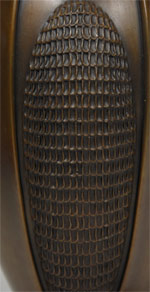 Al Qöyawayma is one of the most famous Hopi potters of the contemporary scene. He entered the art scene around 1970 and is still actively making pottery. Less known are his bronze sculptures but they are just as exciting as his unique pottery.
Al Qöyawayma is one of the most famous Hopi potters of the contemporary scene. He entered the art scene around 1970 and is still actively making pottery. Less known are his bronze sculptures but they are just as exciting as his unique pottery.
Qöyawayma attributes his pottery style to his aunt, the famous Hopi potter Elizabeth White or Polingaysi Qöyawayma. It was she who started the all-natural clay pottery without slip or design. He added the sculptural aspect to his work while hers was simpler and unadorned.
This bronze sculpture of "Corn Maiden" is a modern manifestation of the most important personage to all Hopi. Every Hopi infant is given a corn mother (perhaps not the correct words) and it stays with them throughout life. Corn is very important to the Hopi and her representation in bronze by Al Qöyawayma is a beautiful rendition in a very contemporary or modern style.
The sculpture was issued in 1985 in an edition of 30 of which this is number 26. It is signed by the artist.
Condition: original condition
Provenance: from the estate of a Colorado collector of fine art
Title: Bronze Sculpture "Corn Maiden"
Artist: Al Qöyawayma
Category: Bronze
Origin: Hopi Pueblo
Medium: bronze, wood
Size: 12" tall x 5" diameter of base
Item # C3356E
Subject: Zuni Pueblo Serving Bowl with Red Underbody
Occasionally we acquire a piece of pottery that is a joy to hold and a visual delight. Such is this marvelous Zuni Pueblo serving bowl. Not only was it constructed by a master potter and painted by a talented artist, it was perhaps lovingly used in the pueblo for decades before someone talked the owner into parting with it. It dates to the last half of the nineteenth century. The paste materials are typically Zuni; white and chunky in texture with the centuries old temper material of ground pottery shards. The use of old shards for temper evidences the regard of the pueblo peoples for the old works made by their predecessors. To add these remnants to the new work is a sign of respect.
The rim of the bowl flares outward slightly, imparting a graceful shape to what could be an otherwise uninteresting one. The bowl is slipped in traditional fashion with cream-colored clay, over which is painted the design in mineral and vegetal paints. The underbody is slipped in red, a tradition generally abandoned in the mid-1860s and completely abandoned by 1880. The exterior is decorated with the traditional prayer stick design used on every Zuni bowl made in the nineteenth century. It is thought that this was a woman's way to place her prayers since women do not make prayer sticks.
The interior decoration begins with a brown rim, below which is a wave-like element encircling the bowl that is painted deep red and outlined in brown. Below this are two wide parallel framing lines with a very distinctive ceremonial break. The main body of the interior is elaborately designed with polka-dotted floral elements and red Zuni volute elements without the addition of brown outlining. The base of the bowl features a red square, outlined in brown, which is again outlined with a wavy brown frame.
This is one of the most extraordinary bowls we have had the pleasure to handle. A two-square-inch piece of clay blew out during firing, but the potter placed it back in and "cemented" it in place so that she could still use the bowl for home use. The piece has been professionally repaired at that point of damage.
Provenance: Cody Wyoming Collection. This Zuni Serving Bowl was part of the exhibit CODY, WYOMING POTTERY COLLECTION June 10, 2006 until September 10, 2006 and BOWLS: A Pueblo Necessity December 15, 2006 until December 31, 2006 presented at Adobe Gallery Santa Fe.
Subject: Zuni Pueblo Serving Bowl with Red Underbody
Potter Unknown
Category: Historic
Origin: Zuni Pueblo
Medium: Native Clay
Size: 4-3/4" deep x 11-1/4" diameter
Item # 24704
Subject: Zuni Pueblo Small Polychrome Heartline Deer Jar
This is an exceptional early twentieth century Zuni Pueblo olla that has possibly seen some use at the pueblo. As is typical of Zuni polychrome wares after 1850, the vessel shape is somewhat squat, resulting in a slight enlargement of the mid-body.
On the neck the decoration is quite elaborate. Note the stylized bird with its arrowhead body squeezed into a brown triangle. Adjacent to the bird element, within the rectangular block are brown outlines containing red parallel lines. The red parallel lines represent rain. Pueblo beliefs are that water jars are linked to rain. Invariably a potter will put some rain elements in the decoration.
The main body of the vessel has a single row of heartline deer above a row of brown outline triangles and brown volute elements, below which is the brown bottom with a concave indentation. The vessel exhibits some wear around its rim, which consists only of some of the brown paint being worn off. There has been some repair at one point of the rim.
Provenance: ex. Cody, Wyoming collection. This Zuni Polychrome Heartline Deer Jar was part of the exhibit CODY, WYOMING POTTERY COLLECTION June 10, 2006 until September 10, 2006 presented at Adobe Gallery Santa Fe.
Subject: Zuni Pueblo Small Polychrome Heartline Deer Jar
Potter Unknown
Category: Historic
Origin: Zuni Pueblo
Medium: Native Materials
Size: 6-1/2" tall x 9" diameter
Item # 24715
Subject: Zuni Pueblo Bowl with Plumed Serpents in Sculpture Relief
Vessels such as this Zuni bowl suggest use in ceremonial functions but most likely that has not occurred. It is more likely that such were made solely to sell to tourists. Zuni elders would not have permitted ceremonial vessels to leave the pueblo and be sold.
An interesting story will illustrate the events that dealers would go to in order to sell pottery, and probably other Native items, in the early 1900s. Museums were eager to acquire ceremonial objects which, of course, were not generally available unless someone from the pueblo sold something without permission to do so.
Because of the desire by museums in the Santa Fe area, the trader at Zuni in the early 1900s seems to have dreamed up a scheme to "find" a cache of Zuni ceremonial pottery jars and sell them to the Laboratory of Anthropology in Santa Fe. Around 1920, a large group of Zuni ceremonial vessels supposedly were available from Zuni and the trader made a deal to sell them to the Lab. There were around 260 of them. The Lab director convinced John D. Rockefeller of New York, who had earlier funded the building for the Lab, to purchase this important and secret collection for a sum of around $10,000, which was a very large amount at the time when jars were selling for maybe $1 or slightly more.
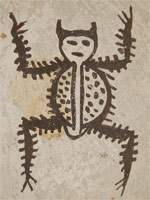 Because the transaction was a hushed-up affair, the cache of jars was stored in a vault at the Lab where they stayed for over 75 years. When Dr. Bruce Bernstein was director of the Museum of Indian Arts and Culture, he became interested in the collection and spent the next 20 years studying them and getting advice from Zuni elders who declared they were not ceremonial in any manner. This was a hoax that was clothed in secrecy and ultimately uncovered. The Zuni were probably innocent of the charade. Potters most likely received orders for ceremonial-like vessels and made them by the trader's specification and sold them without knowing they were being sold as historic.
Because the transaction was a hushed-up affair, the cache of jars was stored in a vault at the Lab where they stayed for over 75 years. When Dr. Bruce Bernstein was director of the Museum of Indian Arts and Culture, he became interested in the collection and spent the next 20 years studying them and getting advice from Zuni elders who declared they were not ceremonial in any manner. This was a hoax that was clothed in secrecy and ultimately uncovered. The Zuni were probably innocent of the charade. Potters most likely received orders for ceremonial-like vessels and made them by the trader's specification and sold them without knowing they were being sold as historic.
This Zuni bowl we are featuring today is not of the style of the ones at the Lab but is a style based on ceremonial vessels used by the Zuni, but, unless a vessel has been used in ceremonial fashion, it is not ceremonial even if it is of the same style. The use of water creatures-in this case frogs, dragonflies, tadpoles, and plumed serpents-is standard fare on ceremonial vessels, so this bowl could be labeled "pseudo-ceremonial" if one wished to do so. The plumed serpent is known as Kolowisi at Zuni and is an important water creature. Kolowisi is a hero to the Zuni because he saved them from a flood and provided sustenance to them at the time. After the flood, he stayed at the pueblo and resides underground in a lake. He can and does appear in irrigation acequias and the Zuni River or any other body of water and serves as a guardian of water sources.
This bowl has 7 terraces around the rim and a footed base, elements generally not used except on ceremonial bowls. On the exterior of the bowl are five frogs and two dragonflies painted in brown as is the rim of the bowl. On the interior are five tadpoles and a frog also painted in brown. The bodies of a pair of Kolowisi are raised on the clay body and painted in brown and red and outlined in brown. The heads of the serpents penetrate the bowl and hang on the exterior. Their heads are brown and the plumes are red.
The bowl evokes an element of mystique and makes one think it is an item used in a secret fashion in some ceremony in a kiva not witnessed by anyone other than high priests or important persons. It feeds that need in us to feel we have discovered something that is rare and wonderful, which, in reality, is true. These are rare and wonderful and one is fortunate to be able to add one to a collection.
Condition: original condition
Provenance: from a family in Santa Fe
Recommended Reading: The Pottery of Zuni Pueblo by Francis Harlow and Dwight Lanmon
Subject: Zuni Pueblo Bowl with Plumed Serpents in Sculpture Relief
Potter Unknown
Category: Historic
Origin: Zuni Pueblo
Medium: clay, pigments
Size: 5" deep x 9-1/2" diameter
Item # C3357
Biography: Abel Sanchez (1899-1971) Oqwa Pi - Red Cloud
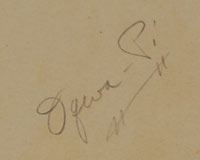 Abel Sanchez, or Oqwa Pi, as he was known in his Native language, had very little art instruction except for a few classes he took at the Santa Fe Indian School.
Abel Sanchez, or Oqwa Pi, as he was known in his Native language, had very little art instruction except for a few classes he took at the Santa Fe Indian School.
Clara Lee Tanner in her book, Southwest Indian Painting: a Changing Art, says that Sanchez was noted in history for preserving and carrying on "many of the trends that might be thought of as 'native,' inasmuch as they were developed by Indians without any instruction."
Characteristic of Oqwa Pi's style, there were no backgrounds, foregrounds, or ground lines, and he painted heads that were disproportionate to their bodies. The latter fact alone makes his art primitive, charming and true to the folk art style.
Subject: San Ildefonso Pueblo Original Painting of Two Antelope
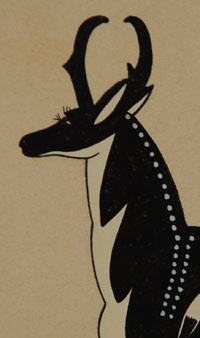 Abel Sanchez was known as Oqwa Pi in the Tewa language. He was the grandfather of San Ildefonso potter Russell Sanchez. Except for what little instruction he received at the Santa Fe Indian School, he had no other formal training. To quote the artist: "I, Oqwa Pi, have been painting since the early 1920s. As I found that painting was the best among my talents, I decided to do my best to win me fame as an Indian artist....as an artist, I have raised a big, healthy family for my painting brought in good income...." Artist letter to Philbrook Art Center
Abel Sanchez was known as Oqwa Pi in the Tewa language. He was the grandfather of San Ildefonso potter Russell Sanchez. Except for what little instruction he received at the Santa Fe Indian School, he had no other formal training. To quote the artist: "I, Oqwa Pi, have been painting since the early 1920s. As I found that painting was the best among my talents, I decided to do my best to win me fame as an Indian artist....as an artist, I have raised a big, healthy family for my painting brought in good income...." Artist letter to Philbrook Art Center
Characteristic of Oqwa Pi's style, there are no backgrounds, foregrounds, or ground lines. This tends to make his art charming and true to the folk art style and certainly true to the Santa Fe Indian School style. The fresh color and action and the great simplicity of his paintings made the works of his well received in exhibits at the Milwaukee Art Institute, Yale University, Museum of Modern Art in New York City, Stanford University and the Gallery of Fine Arts in Muskegon, Michigan.
This simple black and white painting of a pair of antelope easily demonstrates his outstanding artistic talents. Each animal is well illustrated and their positions opposing each other are more creative than most artists who tend to have them facing in the same direction. Oqwa Pi was a very talented self-taught artist who was well appreciated when he was alive and is well appreciated still today.
Condition: This painting was delivered to us without a frame so we were able to examine the paper. We found no significant discoloration or acid burn. There is one brown spot in lower center of the paper and a small water spot close to that, otherwise there is no damage.
Provenance: acquired from a couple from Massachusetts.
Recommended Reading: Southwest Indian Painting: a Changing Art by Clara Lee Tanner. (There is one copy of this out of print book available from us at $95. It was formally in the Central Library, Finger Lakes Library System, Ithaca, NY).
Artist: Abel Sanchez (1899-1971) Oqwa Pi - Red Cloud
Category: Paintings
Origin: San Ildefonso Pueblo
Medium: casein
Size: 9" x 12-3/8" image; 14-3/4" x 18-1/4" framed
Item # 25607
Subject: San Ildefonso Original Painting of two Dancers
Abel Sanchez, or Oqwa Pi, as he was known by his Tewa name, had very little art instruction except for a few classes he took at the Santa Fe Indian School.
Clara Lee Tanner in her book Southwest Indian Painting: A Changing Art says that Sanchez was noted in history for preserving and carrying on "many of the trends that might be thought of as 'native,' inasmuch as they were developed by Indians without any instruction."
Characteristic of Oqwa Pi's style, there were no backgrounds, foregrounds, or ground lines. The primary figures of his study were the only images on the paper.
The artist's subjects appear to be in action, but in a very subtle way. In this Oqwa Pi painting the dancer in the foreground appears to be walking and the Antelope dancer following him appears to be dancing. This sense of movement was very characteristic of his style. What is lovely about this painting is Oqwa Pi's use of bright colors. The overall detail of the artist's style is evident in the white knit leggings worn by the Antelope dancer and the green headdress he wears. Also the evergreen bough in the other's hand and the details of his moccasins are finely handled. While overall simplistic, he captures the spirit and mood of this wonderful Pueblo dance.
Condition: The painting was delivered to us without a frame so we were able to inspect it and we found no noticeable damage to the paper but there is a small red spot on the front dancer's shirt, where it overlaps the neck tie, that appears to have been professionally touched up with pigment. It has been framed using all acid-free materials and a simple dark wood frame. It is signed "Oqwa Pi" at lower right. The paint colors are still brilliant.
Provenance: acquired from a couple from Massachusetts.
Recommended Reading: Southwest Indian Painting: a Changing Art by Clara Lee Tanner.
Subject: San Ildefonso Original Painting of two Dancers
Artist: Abel Sanchez (1899-1971) Oqwa Pi - Red Cloud
Category: Paintings
Origin: San Ildefonso Pueblo
Medium: casein
Size: 9" x 12-3/8" image; 14-3/4" x 18-1/4" framed
Item # 25608
Biography: Rondina Huma (1947 – )
Rondina Huma was born in Keams Canyon, Arizona, and is a member of the Tewa Kachina/Parrot clan. She has lived in the village of Polacca since childhood.
Huma produces the most perfect vessel, balanced in every respect and burnished to a smooth and beautiful finish, upon which she applies a total composite design that completely conceals the base surface. Her designs are minute or thumbnail images of Sikyatki prehistoric designs from her pueblo's ancestral village.
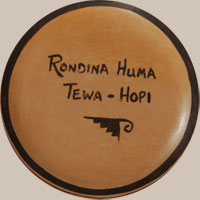 She has been one of the most sought after Hopi potters for over a decade now. She has been featured in many publications and her work is represented in major galleries and museums throughout the country. There is no mystery as to why Rondina has won many awards over the years for her exquisite work. She deserves every accolade bestowed on her. Rondina walked away with awards from the Santa Fe Indian Market. One of her pieces was awarded Best of Show (Santa Fe Indian Market in 1986 and again in 1996), Best of Division, and Best Traditional Pottery. She is recognized for her intricate designs, incorporating hundreds of small elements. Her polish is exceptional and her painting remarkable.
She has been one of the most sought after Hopi potters for over a decade now. She has been featured in many publications and her work is represented in major galleries and museums throughout the country. There is no mystery as to why Rondina has won many awards over the years for her exquisite work. She deserves every accolade bestowed on her. Rondina walked away with awards from the Santa Fe Indian Market. One of her pieces was awarded Best of Show (Santa Fe Indian Market in 1986 and again in 1996), Best of Division, and Best Traditional Pottery. She is recognized for her intricate designs, incorporating hundreds of small elements. Her polish is exceptional and her painting remarkable.
Huma had no formal training in pottery making, yet she is a master of the art. Her pottery is traditional in every manner-- she does the entire process in the traditional Hopi fashion using nothing but native materials, even to fashioning her own paint brushes from the leaves of the yucca plant. She hand coils all her vessels and uses only vegetal and mineral paints. Traditional firing is carried out as well.
She signs her pottery Rondina Huma Tewa-Hopi, and also with her clan symbol, a parrot.
Subject: Hopi Polychrome Bowl with Beautiful Blush
Rondina Huma has been one of the most sought after Hopi potters for over a decade now. She has been featured in many publications and her work is represented in major galleries and museums throughout the country. There is no mystery as to why she has won many awards over the years for her exquisite work. She deserves every accolade bestowed on her. Her pottery is traditional in every manner. She hand coils all her vessels and uses only vegetal and mineral paints. Traditional firing is carried out as well.
I do not know the exact extent of her recent eye surgery or problems, but she has had problems with her sight for the past two years. Presumably, and hopefully, she will regain full use of her sight.
This bowl is an older one from a private collection and is absolutely a jewel from a master potter. Take a look at the large array of parallel black lines throughout the bowl and imagine the patience and experience one would have for doing such.
Condition: original condition
Provenance: from an Arizona resident
Recommended Reading: Hopi-Tewa Pottery: 500 Artist Biographies by Gregory and Angie Schaaf
Subject: Hopi Polychrome Bowl with Beautiful Blush
Artist / Potter: Rondina Huma (1947 - present)
Category: Contemporary
Origin: Hopi Pueblo
Medium: clay, pigment
Size: 4-1/8" deep x 8" diameter
Biography: Gustav Baumann (1881-1971)
Born in Madgeburg, Germany, Gustave Baumann is best known for prints made from his detailed hand-carved wood blocks.
His family immigrated to the United States when he was a child, and he grew up in Chicago. He returned to Germany to study in Munich at the Kunstgewerbe Schule and then took further training at the Art Institute of Chicago. He spent time in Indiana, and is much associated with the artists who gravitated to Brown County. In that state, Bauman made woodblocks illustrating work by Indiana authors.
Baumann and several other artists decided to see firsthand the reportedly light, clear air of New Mexico that they had been hearing about from other Chicago artists, and in 1918, he settled in Santa Fe where, for over fifty years, he participated in the art community.
He created colored wood blocks from which he made prints, and also became a carver of saints and marionettes, working the Marionette Theater, and carving his 'little people.' He also did numerous paintings in bright colors.
His woodcut subjects are church figures, scenes of sacred Indian pictographs, and landscapes including the Grand Canyon.
During the 1930s, he was WPA coordinator for Santa Fe.
Source: Peggy and Harold Samuels, Encyclopedia of Artists of the American West
Biography: Garnet Pavatea (1915-1981) Flower Girl
 Garnet Pavatea was known as Flower Girl and she was a Hopi-Tewa from the Tewa Village on First Mesa on the Hopi Reservation, and also lived there. Her dad, Dewakuku, was Hopi and her mother was Tewa. Following tradition, Garnet was of her mother's clan.
Garnet Pavatea was known as Flower Girl and she was a Hopi-Tewa from the Tewa Village on First Mesa on the Hopi Reservation, and also lived there. Her dad, Dewakuku, was Hopi and her mother was Tewa. Following tradition, Garnet was of her mother's clan.
Garnet had a long and productive career of pottery making and was a favorite of collectors of Hopi pottery. She was an active potter from circa 1940 to circa 1981. She is best known and was fond of making plain red bowls and jars with triangular indentations around the rim as the sole decoration. Often, she made ladles to accompany her bowls. The Museum of Northern Arizona in Flagstaff amassed a major collection of her work. She passed away in 1981.
Biography: Frances P. Torivio (1905-2001)
 Frances Torivio was a sister of Lolita Concho and the mother of Lilly Salvador and Wanda Aragon. Frances was one of the important matriarchs of Acoma and she made large jars in the prime of her life. She was still attending Indian Market in 2001 at the grand age of 96, and proudly displaying smaller pieces of pottery.
Frances Torivio was a sister of Lolita Concho and the mother of Lilly Salvador and Wanda Aragon. Frances was one of the important matriarchs of Acoma and she made large jars in the prime of her life. She was still attending Indian Market in 2001 at the grand age of 96, and proudly displaying smaller pieces of pottery.
Frances was listed in the book Nacimientos - Nativity Scenes by Southwest Indian Artisans in the "Additional Nativity Artisans" section. To quote the authors "Frances Torivio began making Nativities several years ago. The figures range from 1-1/2 to 4 inches high and are realistically modeled with clearly defined arms and legs and extensive detailing. She uses the typical Acoma clay with details in orange and black."
Subject: Historic Polacca Polychrome “Style C” Bowl, circa 1860-1880
Polacca pottery style began around 1740. It did not fully become the predominant type at Hopi until about 1800, and it continued until about 1890. Polacca wares were the predominant utilitarian wares of this time period. This bowl is typical of Polacca Polychrome, Style C, which existed in the late-1800s.
Victor Mindeleff at Hopi (Moqui) collected this bowl in 1883 for the Smithsonian. On the interior of the bowl, below the rim, is inscribed, in India ink, 83620 Moqui Bureau of Ethnology.
What we generally consider to be Zuni Pueblo designs were quite prevalent on Polacca vessels. The designs on this bowl are a good example of this. Two major volute design elements fill the interior of the bowl, and a proliferation of feather elements cover the exterior. A red underbody and a black rim complete the decoration.
Condition: The bowl was broken cleanly in half and reassembled without any attempt to conceal the break. A chip to the rim was professionally restored. Breakage on pottery of the significance of this one is not considered to be detrimental. The collection history overshadows the previous breakage which could have happened at the time of collection in 1882.
Provenance: "In 1882, Victor and Cosmos Mindeleff led an expedition to Zuni and Hopi villages to survey archaeological ruins and historic villages.....In November and December 1882 and January 1883, while Victor Mindeleff helped the Stevensons to survey Canyon de Chelly, Cosmos Mindeleff and Cushing traveled to the Hopi reservation and tried to collect on Third Mesa. Experiencing great opposition, they moved to Mishongnovi on Second Mesa and collected over 5000 pots, baskets, household objects, and agricultural tools, 4166 of which were accessioned."
Using the Smithsonian accession number painted on the interior of the bowl, the Smithsonian staff verified for us the bowl to be one of the pieces collected by Cosmos Mindeleff in 1882. The Smithsonian de-accessioned the bowl but their records do not indicate when or to whom. The Smithsonian at that time was overwhelmed with the sheer amount of items being collected in New Mexico and Arizona pueblos that it gave many items to other museums. Over the years, these museums have de-accessioned some of those items which accounts for their being on the market for sale.
Quotation from "The Formation of Ethnographic Collections: The Smithsonian Institution in the American Southwest," by Nancy J. Parezo, in Advances in Archaeological Method and Theory, 10, Michael B. Schiffer, editor (1987): 1-47.
Recommended Reading: Canvas of Clay by Edwin Wade and Allan Cooke
Title: Historic Polacca Polychrome "Style C" Bowl, circa 1860-1880
Potter Unknown
Category: Historic
Origin: Hopi Pueblo
Medium: Native Clay
Size: 5" deep x 11" diameter
Item # C3361A
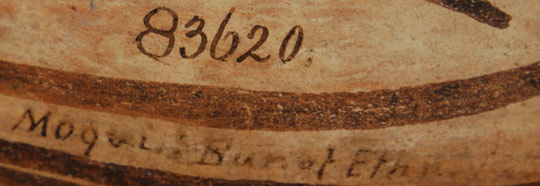
Subject: Acoma Four-color Olla with Parrot Design
Frances Torivio was a sister of Lolita Concho and the mother of Lilly Salvador and Wanda Aragon. She was one of the important matriarchs of Acoma and made large jars in the prime of her life. She was still attending Indian Market in 2001 at the grand age of 96, and proudly displaying smaller items.
She was one of the important matriarchs of Acoma Pueblo pottery families and had gained fame as an outstanding potter. In 1976, she taught traditional pottery-making classes not only for her own family, but for many, many more at the pueblo. She once described how she and her sister, Lolita Concho, learned pottery making the hard way, without someone to teach them. Torivio gained fame as an outstanding potter, as did her sister.
Torivio never fell into the trend of other Acoma potters who started painting green ware pottery or firing in a commercial kiln. She always continued following ancient techniques of acquiring her clay from Mother Nature, grinding up potsherds for temper, hand coiling the pottery, using all native materials for paints, and firing the pottery in the traditional outdoors technique.
This jar is a small water jar with parrots and rainbows as the prime design. Rainbows of two different colors hover over parrots on opposing sides, and parrots perched on flowers appear of opposing sides. The standard three colors of white, black and red appear with a fourth color of rose. The jar is well constructed and beautifully painted.
Condition: very good condition
Provenance: from a gentleman in Colorado
Recommended Reading: Acoma and Laguna Pottery by Rick Dillingham
Subject: Acoma Four-color Olla with Parrot Design
Artist / Potter: Frances P. Torivio (1905-2001)
Category: Contemporary
Origin: Acoma Pueblo
Medium: clay, pigments
Size: 8-1/2" x 9-1/4" diameter
Item # C3354E
Title: Navajo Folk Art Wood Carving “Man on Motorcycle”
Harrison Juan has been carving the cottonwood he finds along the creek beds of the San Juan River for over 35 years. He was born in Lake Valley and became interested in making art while observing his uncle, Johnson Antonio, a Navajo folk art artist. He remembers that he cut wood for Antonio and ran errands for him in the beginning. Juan's goal is to become self-sufficient as an artist, but he has been working on and off in construction for support.
"I just try to keep it going," the artist explained to the Rosenaks, "showing the joys of reservation life and Navajo people at gatherings, ceremonies, and just the fun of friends being together at local posts. I carve the older people and show how they are dressed ... and sporting their best jewelry."
Juan's carvings can be more serious at times as he captures the older generation but also his generation at work, riding motorcycles, or just hanging out. In winter, when the Yeis are dancing, he will sometimes place his subjects at ceremonies-his goal is highlighting the stories of his people.
This carving of a Navajo male riding a motorcycle is an excellent example of the fine carving seen in Juan's work. The details shown in the tires and the engine compartment are exceptional. The overall proportion of rider and vehicle is to scale.
Condition: original condition
Provenance: from the collection of Jan and Chuck Rosenak. Published in Navajo Folk Art by Chuck and Jan Rosenak, page 63
Recommended Reading: Navajo Folk Art by Chuck and Jan Rosenak
Title: Navajo Folk Art Wood Carving "Man on Motorcycle"
Artist / Carver: Harrison Juan (1953-present)
Category: Other Items
Origin: Diné - Navajo Nation
Medium: wood, paint
Size: 13-3/4" long x 6-1/2" wide x 10-1/2" tall
Item # C3347K


